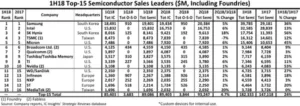Samsung has extended its number one semiconductor ranking and sales lead over Intel to 22%, according to IC Insights. The top-15 worldwide semiconductor sales ranking for the first half of 2018 includes seven suppliers headquartered in the US, three in Europe, two each in South Korea and Taiwan and one in Japan.
All but four of the top-15 companies had double-digit year-on-year growth in the first half of the year. Moreover, seven companies had 20% or higher growth, including the five big memory suppliers — Samsung, SK Hynix, Micron, Toshiba/Toshiba Memory and Western Digital/SanDisk — as well as Nvidia and ST.
The top-15 ranking includes one pure-play foundry (TSMC) and four fabless companies. If TSMC were excluded from the top-15 ranking, Apple would have been ranked 15th. Apple is an anomaly in regards to major semiconductor suppliers. The company designs and uses its processors only in its own products — there are no sales of the company’s MPUs to other system makers. IC Insights estimates that Apple’s custom ARM-based SoC processors and other custom devices had a “sales value” of $3.5 billion in the first half of 2018.
IC Insights says it includes foundries in the top-15 semiconductor supplier ranking since it has always viewed the ranking as a top supplier list, not a market share ranking, and realises that, in some cases, semiconductor sales are double-counted. With many acting as vendors to the semiconductor industry, excluding large IC manufacturers like the foundries would leave significant gaps in the list of top semiconductor suppliers, IC said.
In May 2018, Toshiba completed the $18 billion sale of its memory IC business to the Bain Capital-led consortium. Toshiba then repurchased a 40.2% share of the business. The Bain consortium goes by the name of BCPE Pangea and the group owns 49.9% of Toshiba Memory Corporation (TMC). Hoya owns the remaining 9.9% of TMC’s shares. The new owners have plans for an IPO within three years. Bain has said it plans to support the business in pursing merger and acquisition targets, including potentially large deals.
As a result of the sale of Toshiba’s memory business, sales results from the second quarter of 2018 include the combined sales of the remaining semiconductor products at Toshiba and the new Toshiba Memory’s NAND flash sales.
In total, the top-15 semiconductor companies’ sales surged by 24% in the first half of the year compared to the first half of 2017, four points higher than the total worldwide semiconductor industry year-on-year increase of 20%. Samsung, SK Hynix and Micron each registered greater than 35% year-on-year growth in the first half of 2018. Fourteen of the top-15 companies had sales of at least $4 billion, three companies more than in the first half of 2017.
Intel was the number-one ranked semiconductor supplier in the first quarter of 2017 but lost its lead spot to Samsung in the second, as well as in the full-year 2017 ranking, a position it had held since 1993. With the continuation of the strong surge in the DRAM and NAND flash markets over the past year, Samsung went from having only 1% more total semiconductor sales than Intel in the first half of 2017 to having 22% more in the first half of 2018.
Memory devices are forecast to represent 84% of Samsung’s semiconductor sales in 2018, up from 81% in 2017 and 71% in 2016. Moreover, the company’s non-memory sales in 2018 are expected to be only $13.5 billion, up 8% from 2017’s non-memory sales level of $12.5 billion. In contrast, Samsung’s memory sales are forecast to be up 31% this year and reach $70 billion.

